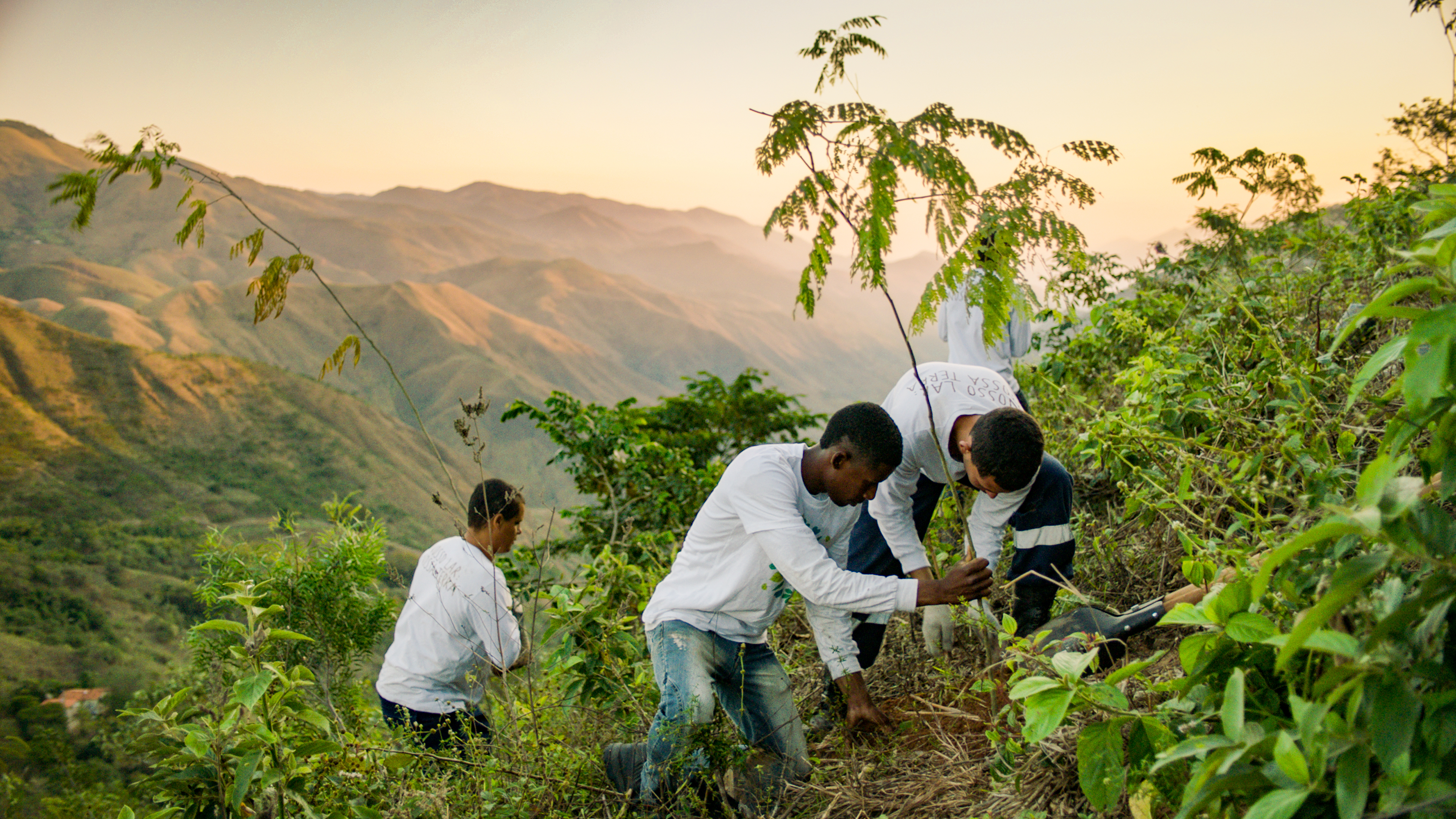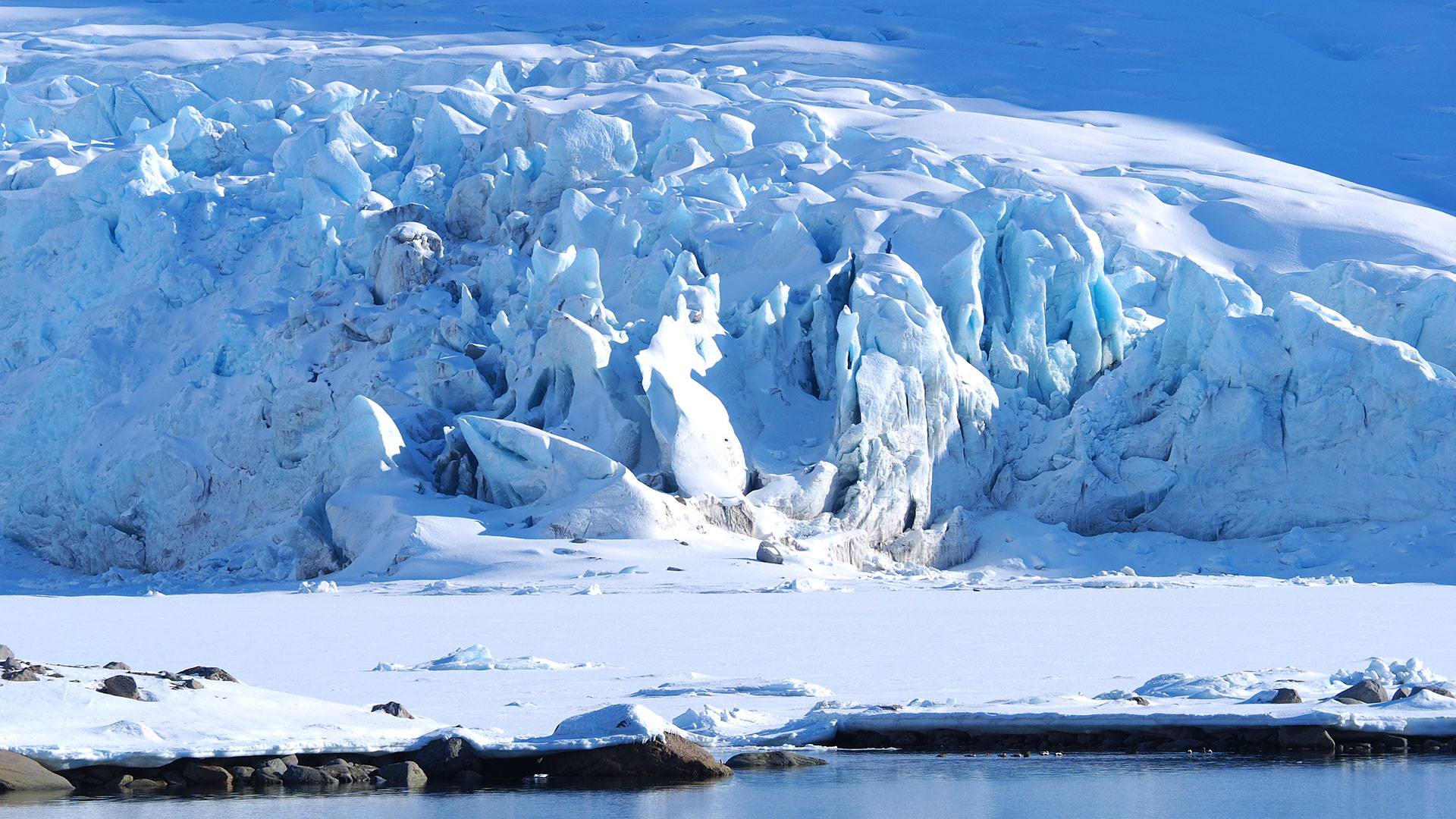
WHY SO URGENT
WE ARE WITNESSING RUNAWAY CLIMATE CHANGE IN REALTIME
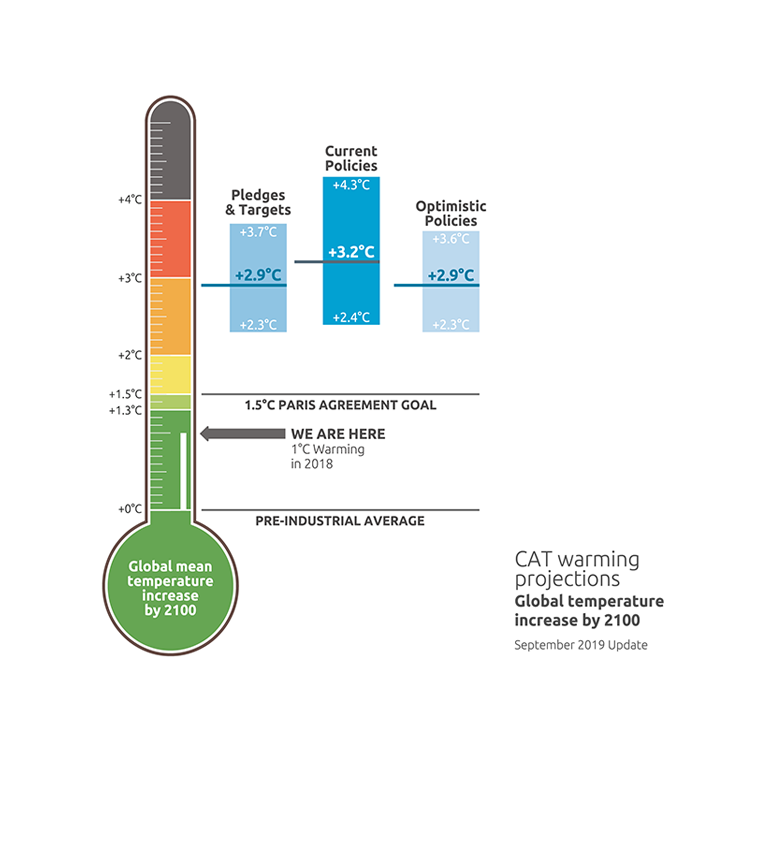
GLOBAL WARMING CRISIS
Global warming has reached a crisis point, prompting the view among experts that we are reaching the end-game. Humanity will soon need to choose between taking unprecedented action or suffer the consequences, because projected warming of more than 3°C poses a threat to our very existence [93]. Many who study climate science now believe that we are at a planetary threshold, which could lock in changes to far hotter and drier conditions, a ‘Hothouse Earth’ [94]. They believe that warming will be reinforced by feedback systems so that the trajectory could not be reversed, steered or substantially slowed.
In 2018 the IPCC published a report warning that we have only about a decade to limit global warming to 1.5°C. Beyond this, we risk significantly worse droughts, floods, extreme heat and poverty for hundreds of millions of people [95].
If countries honour their current Paris pledges to limit emissions, the atmosphere is likely to warm by 3.0°C by 2100, as shown in the 2017 Climate Action Tracker graphic [96]. This is well beyond the 1.5-2°C limit considered to be the threshold of dangerous climate change.
By 2030, which is effectively the near future, climate change is expected to drive more than 100 million people into extreme poverty [97], when unprecedented heat waves, more intense cyclones and floods will drive widespread food shortages [98]. By 2050, the number of undernourished people is expected to increase substantially [99], one result of which will be around 150 million climate refugees [100].
But there is still hope... agriculture and land use provides two powerful circuit-breakers on global warming, as we shall see in the diet change section further down this page.
IF CURRENT DIETARY TRENDS CONTINUE METHANE AND NITROUS OXIDE EMISSIONS WILL MORE THAN DOUBLE BY 2055
“If current dietary trends (increasing global consumption of animal products) were to continue, emissions of CH4 and N2O would more than double by 2055 from 1995 levels.” [180].
BY 2050 FOOD GHG EMISSIONS WILL INCREASE BY 80%
“By 2050 global agricultural greenhouse gas emissions are projected to increase by 80%.” [101]
BY 2033 WIDESPREAD FOOD SHORTAGES, UNPRECEDENTED HEAT WAVES AND CYCLONES WILL BE COMMONPLACE
“If the world warms by 2°C, which may be reached in 20 to 30 years, it will cause widespread food shortages, unprecedented heatwaves, and more intense cyclones.” [102]
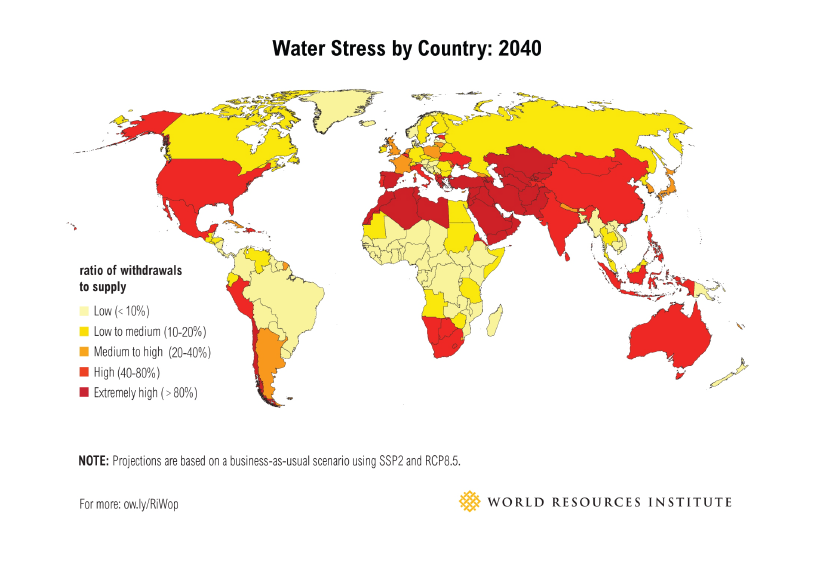
WATER STRESS GLOBALLY
Overuse of above-ground water has caused famine and conflict, particularly in the Middle-East and Africa. Overuse of groundwater has resulted in sinking water tables and agricultural insecurity. Climate change multiplies this threat. Water scarcity has already created millions of climate refugees, heightened international tension and even resulted in armed conflict.
Many countries and regions are now experiencing water shortages, and by 2030, half the world's population will be living in areas of high water stress, and the world will be facing a 40% global water deficit [103]. The World Resources Institute tracks water use and deficits, projecting water stress to be high and extremely high for many highly populated countries (see below) [104].
BY 2040 FOOD SHORTAGES WILL LEAD TO THE COLLAPSE OF SOCIETY
“Society will collapse by 2040 due to catastrophic food shortages… based on plausible climate trends, and a total failure to change course, the global food supply system would face catastrophic losses, and an unprecedented epidemic of food riots… In this scenario, global society essentially collapses as food production falls permanently short of consumption.” The Independent, 22 June 2015, referring to [104].
GLOBAL CROP YIELDS WILL FALL BY 30% FROM WARMING TEMPERATURES
“By 2050 climate change will have a negative impact on agriculture and human well being. Irrigated wheat yields will fall by about 30% and irrigated rice yields by about 15% in developing countries.” [105].
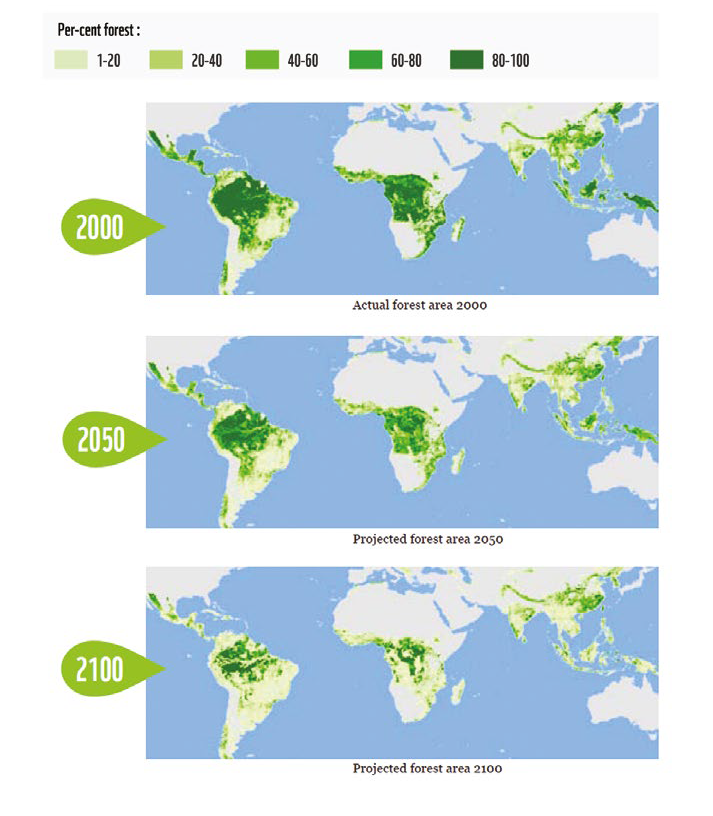
FORESTS, PARTICULARLY TROPICAL FORESTS, ARE UNDER THREAT.
RAINFORESTS HAVE 100 YEARS LEFT
“If the current rate of deforestation continues, the world’s rainforests will vanish within 100 years.” [106].
Forest destruction and degradation produces a fifth of global greenhouse emissions, accelerates biodiversity loss and costs trillions of dollars in lost services to the environment such as cleaning air, recycling water and reducing land slip and flood damage. Fires used to stop forest regrowth are a major source of harmful black carbon, smoke and other pollutants.
Forest destruction, termed ‘land-use change’ is fast approaching a planetary boundary. Overstepping a planetary boundary risks all life on Earth; although overshoot is possible in the short term, we are increasingly exposed to these risks in the long term. Forest destruction is reaching a point that risks environmental collapse, and exceeding this planetary boundary has been projected to be as soon as 2025-2035 [107].
NASA has been monitoring deforestation closely, and in 2001 projected that if the rate of forest destruction continues, the world’s rainforests will vanish by 2100 [108]. This projection is based on deforestation rates, and is not inconsistent with the planetary boundary being overstepped several decades earlier: once degradation to an ecosystem reaches a tipping point, it is a matter of time until the ecosystem is irreversibly changed.
This risk is magnified due to deforestation’s role in climate change, another planetary boundary that is in grave danger of being exceeded. Forests are themselves affected by climate change, particularly changes in rainfall, such that in many regions their ability to absorb carbon dioxide will diminish. Some models predict that the Amazon will be dominated by savannah-like vegetation by the end of the century [109].
Agriculture is by far the greatest threat to forests, and below we discuss how changes to agriculture can halt forest loss.

THE WORLD IS IN THE GRIPS OF THE SIXTH MASS EXTINCTION.
The cause – human impact. Biodiversity, the web of life that we depend on for food, water and health is being destroyed. Plants and animals are becoming extinct 1,000 times faster than past natural rates of extinction [110].
Past extinction events have wiped out as much as 85% of life on Earth, and the current extinction rate is judged to be as serious as past events [111]. Loss of biodiversity is now considered to have passed a planetary boundary, which by definition endangers all life on Earth [112]. Biology experts are now trying to convey the seriousness of the situation in articles published in leading journals with statements such as:
“the sixth mass extinction is already here and the window for effective action is very short.”
“This “biological annihilation” underlines the seriousness for humanity of Earth’s ongoing sixth mass extinction event." [113]
Biodiversity loss is caused by loss or fragmentation of habitat, and if we examine how we use the land that was home to native fauna and flora prior to human occupation, we find that of the land used by humanity, 85% is devoted to livestock pastures and feed crops [114].
70% OF ALL SPECIES EXTINCT IF TEMPERATURES INCREASE BY 3.5°C
“If the global average temperature increase exceeds about 3.5°C, model projections suggest between 40% and 70% of species assessed around the globe will face extinction.” [115]
FISH EXTINCTION BY 2048
“If fishing rates continue apace, all the world’s fisheries will have collapsed by the year 2048.” [116].
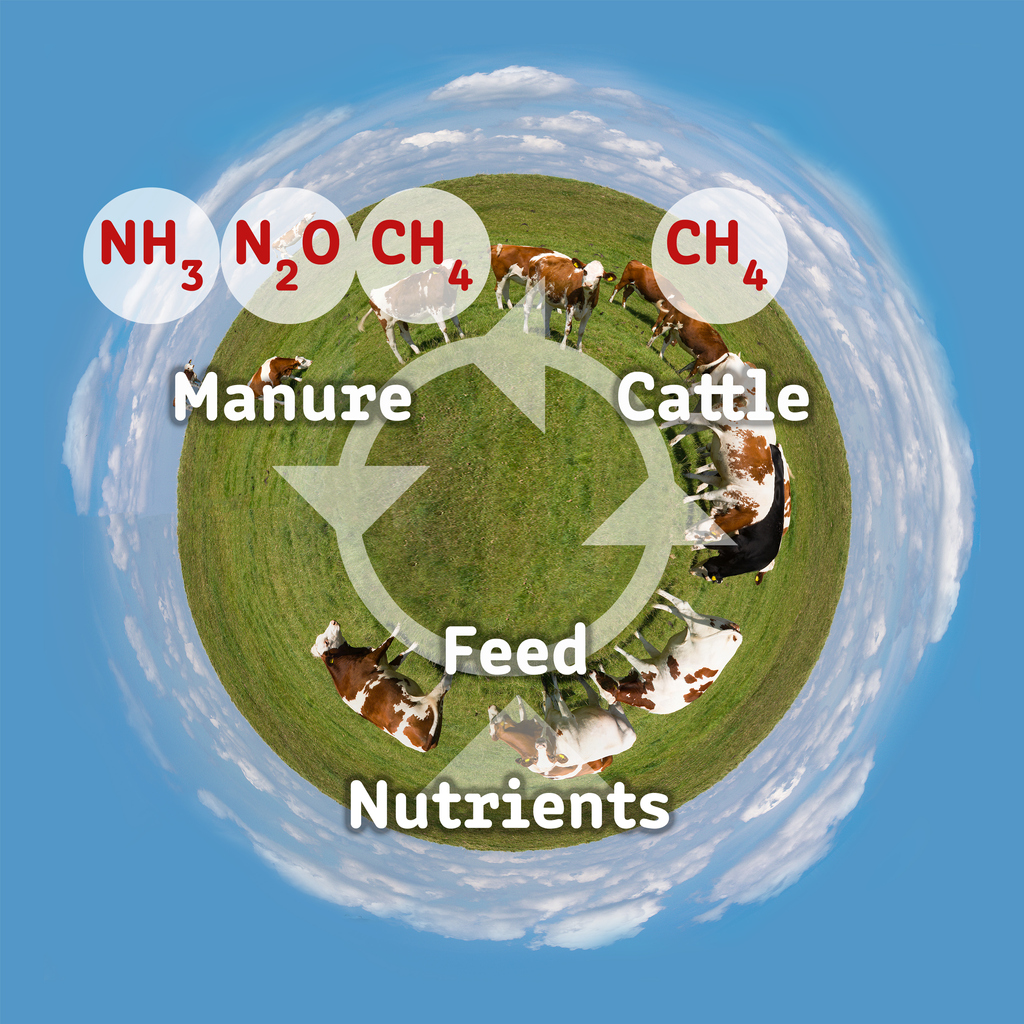
PLANETARY BOUNDARY PASSED
Nitrogen pollution has well and truly crossed a planetary boundary, threatening life on Earth [117].
Synthetic nitrogen fertilizer has enabled the ‘green revolution’ to feed humanity’s rapid population growth, however the world is now awash in reactive nitrogen. This has been identified as the single greatest cause of environmental pollution [118], creating lifeless waterways, toxic tides and hundreds of permanent ocean dead zones.
Nitrogen is all around us. The air is mostly made up of stable nitrogen, but nitrogen in its reactive form is the basis of life: nitrogen is the essential building block of proteins. When we apply nitrogen fertilizer to growing plants, proteins are created. When people eat plants, some of these proteins become part of our bodies, but most is lost. When we eat animals rather than the plant directly, this waste is multiplied in the process. The most wasteful example of this process is beef production. If we eat beef, just 4% of the nitrogen is taken up as protein in our bodies, [21]. The rest is waste and ultimately ends up in our waterways.
This conversion process from plant to meat concentrates nitrogen waste, particularly with intensive livestock production. In this way, most of the nitrogen applied to crops or from natural processes becomes waste and pollution, that ends up choking waterways and the air we breathe.
Although this problem has been known for some time, until recently the focus has been on optimum fertilizer application rates to maximise crop productivity but minimise loss. In recent years, however, studies are now addressing food nitrogen efficiency, concluding that a move away from livestock towards a plant-based diet is the most effective means of addressing this planetary boundary crisis.
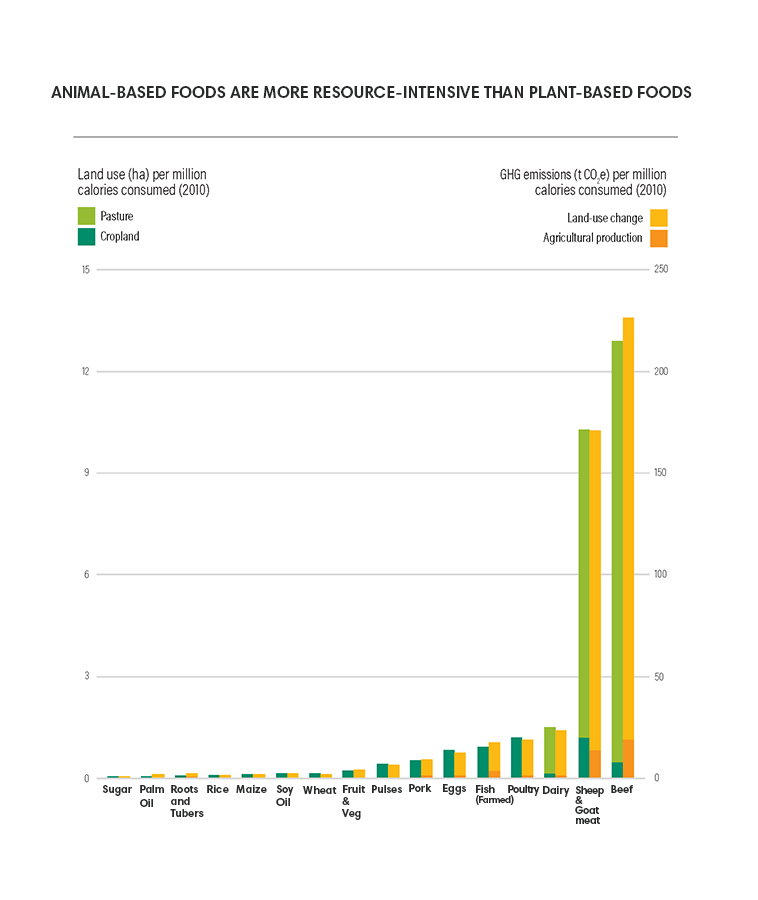
SHORT-TERM EMISSIONS FROM METHANE
- Warming from methane alone will cause 1.5°-2°C warming even if carbon dioxide emissions are cut to zero.[22]
- Livestock are the greatest source of methane and nitrous oxide emissions.[23]
- Livestock cause more warming than fossil fuels, when measured over a 20-year accounting period, rather than the 100-year accepted convention.
- The difference between the FAO estimate that livestock cause 14.5% of global warming, and the Worldwatch article estimate of 51% is in large part due to the choice of 20-year vs 100-year accounting period.
- Methane’s short 10-year life in the atmosphere gives a powerful means of slowing global warming in coming years and decades.
METHANE LASTS ONLY 10 YEARS - LET'S FOCUS ON THIS
So we know methane is very potent, but is gone within 10 years. This offers a powerful ‘circuit breaker’ to slow global warming by decades and buy us time to move to renewable energy.
Steep cuts to livestock production will greatly benefit the climate in two ways: it will slow warming the coming critical decades, and in the long term it will draw down carbon dioxide from the atmosphere.
Livestock production, particularly ruminant livestock, is a large and growing source of greenhouse gases and is the greatest source of short-term emissions (methane). Slashing short-term emissions gives us the circuit-breaker desperately needed to stem global warming.
Slashing livestock numbers reduces warming quickly as methane emissions drop.
LIVESTOCK EMISSIONS GREATER THAN GLOBAL TRANSPORT SECTOR
Even using conventional 100-year greenhouse warming factors, emissions from livestock are equivalent to global emissions from transport[24]. Each of us can therefore make a substantial reduction to our personal greenhouse footprint by choosing plant proteins before animal. The above graph from the World Resources Institute shows that emissions from livestock products are many times greater than plant-based foods[25].
Seventy percent of freshwater is used in food production (more in developing countries), with livestock requiring two-thirds of this[30]. Producing animal protein requires up to 100 times more water than plant protein[31]. Reducing livestock numbers therefore provides a powerful solution to relieve stress on current water supplies and ensure water for the future.
The high water use of livestock products makes more sense when we see that about half the grain crops and all the fodder crops grown globally are for livestock feed, not human food[32]. High water use also makes sense when we think that for every human mouth to feed, we have more than ten times more livestock mouths to feed and water: we keep 82 billion animals, and over 2016 we raised 376 billion animals for milk, eggs, and meat[33]. Note that water use figures for grazed livestock such as beef above include the rainfall required to grow pasture, which could be argued is not a water withdrawal. Nevertheless, grazed animals require considerable drinking water, and most are ‘finished’ on a grain diet, often from irrigated feed crops.
Examples such as those above and from the graphic below are empowering by showing water usage for individual foods, because the sum total of agricultural output is merely what we eat, so each of us has the power to positively influence what may seem to be a massive problem beyond our reach.
In 2012 the Stockholm International Water Institute produced the Feeding a Thirsty World report that looked specifically at what savings could be made to ensure we had enough water globally for the projected population in 2050.
They found that[34]:
- There will not be enough water available on current croplands to produce food for the expected 9 billion population in 2050 if we follow current trends and changes towards diets common in Western nations.
- There will be just enough water by 2050 if the proportion of animal-based foods globally is limited to 5% of the total calories we eat.
- This is equivalent to reducing global consumption of animal-based foods by 75%.
Therefore, the solution to this predicament lies with all of us, collectively and individually. We can use one of the several personal water footprint calculators online to track our personal use, and we do not need to wait for government and industry measures to restructure food production, markets and guide consumption. The most powerful action we can take personally to avert the coming water crisis is to change our personal consumption, away from livestock products.

DEFORESTATION DRIVEN BY DEMAND FOR FOOD
Deforestation (70% of which is for livestock) is also a large source of greenhouse emissions, making up 20% of all carbon dioxide emissions[24]. A 2018 report by the Institute for Agriculture and Trade Policy found that the top 20 meat and dairy corporations emit more greenhouse gases than the whole of Germany, and that the top five meat and dairy corporations emit more greenhouse gases than Exxon, Shell, or BP[25].
If grazing lands (currently used primarily to provide red meat and some dairy) are 're-wilded', this releases nearly three-quarters of the human-used land to return to native habitat. This is the least expensive and most effective means we have of halting species population loss and extinctions, as well as the most effective means of halting deforestation. Replanting native species and reforesting degraded land, as well as former pasture land is essential to solve these crises.
Biodiversity loss is caused by loss or fragmentation of habitat, and forests are home to most land species, so preserving forests is critical to preserving species. Considering that, of the land used by humanity, 98% is for food, then it comes as no surprise that food is at once the problem and the solution.
DIET CHANGE ALLOWS US TO RE-WILD
Just as importantly, once pastures are no longer needed, this frees-up more than a third of Earth’s land surface for reforesting, thus hydrating and cooling local climates, increasing productivity and resilience and re-absorbing decades of emissions from the atmosphere. Allowing grazing lands to revegetate and regenerate by removing livestock is by far the lowest cost and most scalable climate mitigation option[26].
The last decade has seen a large number of plans and initiatives aimed at reversing climate change. All credible global climate mitigation plans include forests at the top of the list – both halting deforestation and large scale reforestation (eg [27]).
Regrowing forests is the lowest cost, large scale, natural climate mitigation action we can take. In fact, merely putting a stop to pasture burning will result in natural reforestation without the costs of tree planting. Many pastures worldwide are maintained in this manner, by burning old dead grass from the previous growing season, simultaneously killing new tree and shrub saplings. Fire is used hand in hand with deforestation and to maintain pastures. The most dramatic example of natural regrowth is Africa: if yearly pasture fires were to cease, half the sub-Saharan continent would in time revert to forest [28].
Other studies show that regrowing original vegetation on less than half the area of existing grazing pastures would draw down at least two decades of current emissions[29].
Biodiversity loss can also be caused by humans hunting species for food, such as when overfishing wiped out the North Atlantic cod fish populations[35]. Once again, our food is the culprit.
We now know that worldwide 84% of deforestation is for agriculture[36], most of which historically has been for grazing. In South America, the leading deforestation continent, 86% of forest destruction has been for livestock pastures (71%) and feed crops (14%)[37]. Degradation of ecosystems in drylands are also heavily impacted by livestock, with the major cause of soil erosion and desertification being deforestation and overgrazing”.
A PLANT-BASED DIET CAN SOLVE BIODIVERSITY LOSS
In 2010 the Netherlands Environmental Assessment Agency published a major report into the most effective means for halting the alarming rate of biodiversity loss. They looked at a range of options, including the expansion of national parks and protected areas by up to 50%, reducing deforestation and improving forest management through various means, increasing crop yields and reducing post-harvest losses, as well as global diet change to a ‘healthy’ diet and a ‘no meat’ diet[38].
The ‘no meat’ diet was found to be the most effective in preventing mean species abundance (biodiversity) loss, with the next most effective means being increasing protected areas by 50%; the third most effective being diet change to a ‘healthy’ diet[38].
They found the ‘no meat’ diet to be the most effective to slow biodiversity loss, freeing up almost all grazing to return to native habitat, resulting in a slight increase in crop areas, but preventing over 60% of projected biodiversity loss.
Given that global meat consumption has more than doubled since 1970 and projected to continue its rapid rise, a radical change is required if we are to halt biodiversity loss, which is jeopardising all life on Earth. Such a ‘rescue package’, similar to that introduced after the global financial crisis, has been suggested by biologists, urging that unless such drastic action is taken, we will bankrupt our natural economy[39].
END DEFORESTATION WITH YOUR FOOD CHOICE
If humanity were to adopt a 100% plant-based diet, deforestation would all but cease[40] and natural and assisted regeneration would take over. Already there are many thousand examples of assisted regeneration, such as World Vision’s Farmer Managed Natural Regeneration programme in African countries, to single out one of the multitude of land-care programs globally. Millions of hectares have already been restored in this way.
The most effective means of reducing nitrogen pollution, lifeless rivers and dead ocean zones is to reduce meat production.
Nitrogen is an essential building block for all plants and animals. Its most important role is in protein formation, so that the first-level test for protein content, is nitrogen content.
The Haber-Bosch process of taking nitrogen from the air and fixing it in reactive fertilizer form has been called the most important invention of the 20th century. Nitrogen fixed in this way has largely been responsible for the ‘green revolution’ that has so successfully fed a growing population. We have added vast amounts of fertilizer in addition to natural systems, so much so that we now fix as much nitrogen in fertilizer as that fixed by natural processes[41]. This has effectively doubled the 'carrying capacity' of our planet[42], enabling planet Earth to support humanity and twice our weight in livestock[43], throwing the nitrogen cycle far out of balance, endangering life on Earth[44].
This imbalance is experienced as nitrogen pollution (from here we will use ‘nitrogen’ to refer to reactive nitrogen). When nitrogen fertilizer is applied to a crop, just 30%-50% of it is taken up by the growing plants. When animals (including ourselves) eat plants, most of the nitrogen eaten is excreted, particularly in urine. Pigs are one of the most efficient nitrogen (protein) converters, but even they retain less than one-quarter of nitrogen eaten; beef cattle are the least efficient, retaining just 5% of the nitrogen they eat[45]. Therefore, when we eat animals which themselves have eaten plants or other animals, the nitrogen loss (waste, pollution) is multiplied manifold.
Not only is meat/dairy/egg production wasteful, but most fertilizer follows this nutrient pathway, rather than the direct pathway where humans eat plants. A European study found that of the nitrogen fertilizer applied to crops, just 15% is eaten by humans directly, whereas 85% is consumed by livestock[46]. Livestock production in this way generates and concentrates this pollution, increasing water acidification and eutrophication (where water is stripped of oxygen), carried downstream in watercourses and groundwater in a ‘nitrogen cascade’[47], harming ecosystems that we depend on. Extreme rain events in particular cause waste containments to overflow, where floodwaters accelerate the spread of nitrogen pollution.
To gain a better appreciation of the scale of nitrogen pollution, the effluent from a small 200 cow dairy is equivalent to the sewage waste from a town of 5,000 to 10,000 people[48]. Most human sewage is treated, however waste from concentrated livestock feedlot production is rarely treated.
Many academic and non-government organisations, as well as the United Nations and some state government authors are now calling for a steep reduction in meat and dairy product consumption as the most effective means of dealing with nitrogen pollution. A common recommendation is to halve meat and dairy intake, in what is known as the ‘demitarian’ diet, meaning a 50% reduction in animal product consumption[49],[50].
Two billion hectares of farmland, about a third of all cropland, has become unproductive and abandoned due to degradation and desertification. Half the world’s original topsoil has been lost in the last 150 years and a third of arable land is degraded[51]. It is predicted that if we continue with ‘business as usual’ we will exhaust our ability to farm altogether before the end of this century.
Pressures for food production with limited agricultural land resources are immense, threatening the safe operating space for humanity’s survival on our planet. The way we produce food with current agricultural practices that degrade our finite arable land will not support the projected population, so a drastic change is required.
Soil carbon comes from organic matter, the roots of growing plants, and the remains of fallen plants. One critical aspect of land degradation is the loss of organic matter, where the carbon is released to the atmosphere. Since agriculture began, 133 gigatons of carbon have been lost from the soil organic matter due to agriculture[52]. This is equivalent to 13 years of global fossil fuel emissions and is projected to add another eight years of emissions on top of existing emissions, over the next 40 years[53]. This is seen as one of the greatest challenges in this century.
Drylands, where livestock is grazed, are particularly vulnerable to degradation and eventually to desertification[54]. Climate change, particularly changes to the intensity and frequency of droughts, accelerates the degradation process. Soil carbon loss occurs as a result of soil degradation. The map below shows severe soil loss in red and moderate soil loss in yellow, indicating that this is widespread[55].
Intensive livestock production has been proposed as the solution to reducing pressure on agriculture while increasing food production, but this actually increases the areas of cropland required to feed livestock and is not possible without causing greater loss of forests, placing more pressure on already stressed ecosystems.
Healthy soils support healthy plants, which in turn provide healthy food for us all[56]. Healthy soils are at the heart of a sustainable future, one in which we live within a ‘safe operating space’ of our finite resources. However, soil degradation is fast approaching its limit, threatening food security: the capacity to provide us with sufficient food[57]. Indeed, humanity’s future success as a species is interwoven with how we directly and indirectly manage our planet’s soil[58].
The solution lies in the way we farm and what we produce. Agricultural practices such as no-till farming can slow soil degradation, but this relies on high herbicide inputs. Organic, regenerative and agro-ecological farming can regenerate soils[59], and these practices must be encouraged to grow, replacing today’s large scale, mechanised agriculture. Yields using these new practices are beginning to rival conventional farming, particularly in drought years.
Moving to a plant-based diet, to reduce pressure on cropping soils and free up grazing land, is now seen as inevitable by many experts if we are to have a sustainable future.
Personal action is the most important stand any of us can take to address the perilous environmental predicament we face. Put simply, there are three powerful actions each of us can take that will have a profound impact on our future:
- Eat plants
- Choose organic where possible
- Plant trees.
Knowing that we can make a personal impact on climate, wildlife, forests, water and other serious environmental ills is tremendously empowering. We transform into powerful activists just by our choices at the supermarket. We don’t need to wait for government policy or vested corporate interests to change, we can make the change now.
Choosing to eat and feed the family plant-based foods is far easier now than even a decade ago. Food industries are rapidly adapting to the new trend, offering tasty, nutritious food options, and this trend is accelerating.
As Barack Obama famously said, referring to a call to action by Franklin D Roosevelt, “Go out and make me do it”. The tide of public opinion, science understanding and awareness that ‘business as usual’ is not an option – all these are rapidly changing, but most political systems and some livestock industries are highly conservative and unwilling to change. This places the onus on us.
On top of personal action, we must respond to the political need to “make me do it”. Grassroots activism is needed now more than ever. Voices are being heard now more than ever – social media offers many ways to campaign, and politicians are far more aware that their support depends on being responsive to community demands.
The documentary Eating Our Way to Extinction is a powerful tool to raise awareness and change attitudes. Politicians can be pressured to sit down to take in the important messages. Governments can be pressured to respond to the health cost of livestock that threatens to bankrupt future generations.
We are at a critical juncture. Time is running out. Join the change!

